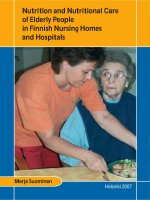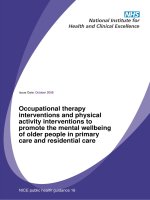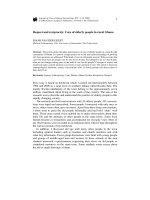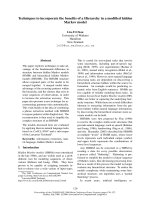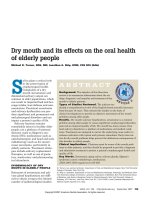Occupational therapy interventions and physical activity interventions to promote the mental wellbeing of older people in primary care and residential care pdf
Bạn đang xem bản rút gọn của tài liệu. Xem và tải ngay bản đầy đủ của tài liệu tại đây (303.27 KB, 50 trang )
Issue Date: October 2008
NICE public health guidance 16
Occupational therapy
interventions and physical
activity interventions to
promote the mental wellbeing
of older people in primary
care and residential care
NICE public health guidance 16
Occupational therapy interventions and physical activity interventions to
promote the mental wellbeing of older people in primary care and
residential care
Ordering information
You can download the following documents from www.nice.org.uk/PH16
• The NICE guidance (this document) which includes all the
recommendations, details of how they were developed and evidence
statements.
• A quick reference guide for professionals and the public.
• Supporting documents, including an evidence review and an economic
analysis.
For printed copies of the quick reference guide, phone NICE publications on
0845 003 7783 or email and quote N1703.
This guidance represents the views of the Institute and was arrived at after
careful consideration of the evidence available. Those working in the NHS,
local authorities, the wider public, voluntary and community sectors and the
private sector should take it into account when carrying out their professional,
managerial or voluntary duties.
Implementation of this guidance is the responsibility of local commissioners
and/or providers. Commissioners and providers are reminded that it is their
responsibility to implement the guidance, in their local context, in light of their
duties to avoid unlawful discrimination and to have regard to promoting
equality of opportunity. Nothing in this guidance should be interpreted in a way
which would be inconsistent with compliance with those duties.
National Institute for Health and Clinical Excellence
MidCity Place
71 High Holborn
London
WC1V 6NA
www.nice.org.uk
© National Institute for Health and Clinical Excellence, 2008. All rights reserved. This material
may be freely reproduced for educational and not-for-profit purposes. No reproduction by or
for commercial organisations, or for commercial purposes, is allowed without the express
written permission of the Institute.
2
Introduction
The Department of Health (DH) asked the National Institute for Health and
Clinical Excellence (NICE) to produce public health guidance for primary care
and residential care on interventions that promote the mental wellbeing of
older people. This guidance focuses on the role of occupational therapy
interventions and physical activity interventions in the promotion of mental
wellbeing for older people. It is anticipated that this is the first of a range of
NICE public health guidance on the health and wellbeing of older people.
The guidance is for NHS primary care and other professionals who have a
direct or indirect role in, and responsibility for, promoting older people’s mental
wellbeing. This includes those working in local authorities and the wider
public, private, voluntary and community sectors. It will also be relevant for
carers and family members who support older people and may be of interest
to older people themselves.
The guidance complements and supports, but does not replace, NICE
guidance on supporting people with dementia and their carers in health and
social care, managing depression in primary and secondary care, assessing
and preventing falls in older people, obesity, commonly used methods to
increase physical activity, physical activity and the environment, behaviour
change and community engagement (for further details, see section 7).
The Public Health Interventions Advisory Committee (PHIAC) has considered
a review of the evidence, an economic appraisal, stakeholder comments and
the results of fieldwork in developing these recommendations.
Details of PHIAC membership are given in appendix A. The methods used to
develop the guidance are summarised in appendix B. Supporting documents
used in the preparation of this document are listed in appendix E. Full details
of the evidence collated, including fieldwork data and activities and
stakeholder comments, are available on the NICE website, along with a list of
the stakeholders involved and NICE’s supporting process and methods
manuals. The website address is: www.nice.org.uk
3
This guidance was developed using the NICE public health intervention
process.
4
Contents
1 Recommendations 6
2 Public health need and practice 12
3 Considerations 15
4 Implementation 19
5 Recommendations for research 20
6 Updating the recommendations 21
7 Related NICE guidance 21
8 References 22
Appendix A Membership of the Public Health Interventions Advisory
Committee (PHIAC), the NICE project team and external contractors 25
Appendix B Summary of the methods used to develop this guidance 29
Appendix C The evidence 39
Appendix D Gaps in the evidence 47
Appendix E Supporting documents 50
5
1 Recommendations
This document constitutes NICE’s formal guidance on occupational therapy
interventions and physical activity interventions to promote the mental
wellbeing of older people.
The evidence statements that underpin the recommendations are listed in
appendix C.
The evidence reviews, supporting evidence statements and economic
analysis are available at www.nice.org.uk/PH16
The definition of ‘mental wellbeing’ used in this guidance follows that
developed by NHS Health Scotland as part of their national programme of
work on mental health improvement. This definition includes areas such as life
satisfaction, optimism, self-esteem, mastery and feeling in control, having a
purpose in life, and a sense of belonging and support (NHS Health Scotland
2006).
Occupational therapy aims to enable people who have physical, mental and/or
social needs, either from birth or as a result of accident, illness or ageing, to
achieve as much as they can to get the most out of life (College of
Occupational Therapists 2008).
If need exceeds the resources available, there should be a focus on the most
disadvantaged older people, for example, those with physical or learning
disabilities, those on very low incomes or living in social or rural isolation,
including older people from minority ethnic groups.
In this guidance ‘older people’ are people aged 65 years and over.
Occupational therapy interventions
Recommendation 1
Who is the target population?
Older people and their carers.
6
Who should take action?
Occupational therapists or other professionals who provide support and care
services for older people in community or residential settings and who have
been trained to apply the principles and methods of occupational therapy.
What action should they take?
• Offer regular group and/or individual sessions to encourage older people to
identify, construct, rehearse and carry out daily routines and activities that
help to maintain or improve their health and wellbeing. Sessions should:
− involve older people as experts and partners in maintaining or
improving their quality of life
− pay particular attention to communication, physical access,
length of session and informality to encourage the exchange
of ideas and foster peer support
− take place in a setting and style that best meet the needs of
the older person or group
− provide practical solutions to problem areas.
• Increase older people’s knowledge and awareness of where to get reliable
information and advice on a broad range of topics, by providing information
directly, inviting local advisers to give informal talks, or arranging trips and
social activities. Topics covered should include:
− meeting or maintaining healthcare needs (for example, eye,
hearing and foot care)
− nutrition (for example, healthy eating on a budget)
− personal care (for example, shopping, laundry, keeping warm)
− staying active and increasing daily mobility
− getting information on accessing services and benefits
− home and community safety
− using local transport schemes.
• Invite regular feedback from participants and use it to inform the content of
the sessions and to gauge levels of motivation.
7
Physical activity
Recommendation 2
Who is the target population?
Older people and their carers.
Who should take action?
Physiotherapists, registered exercise professionals and fitness instructors and
other health, social care, leisure services and voluntary sector staff who have
the qualifications, skills and experience to deliver exercise programmes
appropriate for older people.
What action should they take?
• In collaboration with older people and their carers, offer tailored exercise
and physical activity programmes in the community, focusing on:
− a range of mixed exercise programmes of moderate intensity
(for example, dancing, walking, swimming)
− strength and resistance exercise, especially for frail older
people
− toning and stretching exercise.
• Ensure that exercise programmes reflect the preferences of older people.
• Encourage older people to attend sessions at least once or twice a week by
explaining the benefits of regular physical activity.
• Advise older people and their carers how to exercise safely for 30 minutes
a day (which can be broken down into 10-minute bursts) on 5 days each
week or more. Provide useful examples of activities in daily life that would
help achieve this (for example, shopping, housework, gardening, cycling).
• Invite regular feedback from participants and use it to inform the content of
the service and to gauge levels of motivation.
8
Walking schemes
Recommendation 3
Who is the target population?
Older people and their carers.
Who should take action?
GPs, community nurses, public health and health promotion specialists,
‘Walking the way to health initiative’ walk leaders, local authorities, leisure
services, voluntary sector organisations, community development groups
working with older people, carers and older people themselves.
What action should they take?
• In collaboration with older people and their carers, offer a range of walking
schemes of low to moderate intensity with a choice of local routes to suit
different abilities.
• Promote regular participation in local walking schemes as a way to improve
mental wellbeing for older people and provide health advice and
information on the benefits of walking.
• Encourage and support older people to participate fully according to health
and mobility needs, and personal preference.
• Ensure that walking schemes:
− are organised and led by trained workers or ‘Walking the way
to health initiative’ volunteer walk leaders from the local
community who have been trained in first aid and in creating
suitable walking routes
− incorporate a group meeting at the outset of a walking
scheme that introduces the walk leader and participants
− offer opportunities for local walks at least three times a week,
with timing and location to be agreed with participants
9
− last about 1 hour and include at least 30–40 minutes of
walking plus stretching and warm-up/cool-down exercises
(depending on older people’s mobility and capacity)
− invite regular feedback from participants and use it to inform
the content of the service and to gauge levels of motivation.
Training
Recommendation 4
Who is the target population?
Health and social care professionals, domiciliary care staff, residential care
home managers and staff, and support workers, including the voluntary
sector.
Who should take action?
• Professional bodies, skills councils and other organisations responsible for
developing training programmes and setting competencies, standards and
continuing professional development schemes.
• NHS and local authority senior managers, human resources and training
providers and employers of residential and domiciliary care staff in the
private and voluntary sector.
What action should they take?
• Involve occupational therapists in the design and development of locally
relevant training schemes for those working with older people. Training
schemes should include:
− essential knowledge of (and application of) the principles and
methods of occupational therapy and health and wellbeing
promotion
− effective communication skills to engage with older people
and their carers (including group facilitation skills or a person-
centred approach)
10
− information on how to monitor and make the best use of
service feedback to evaluate or redesign services to meet the
needs of older people.
• Ensure practitioners have the skills to:
− communicate effectively with older people to encourage an
exchange of ideas and foster peer support
− encourage older people to identify, construct, rehearse and
carry out daily routines and promote activities that help to
maintain or improve health and wellbeing
− improve, maintain and support older people’s ability to carry
out daily routines and promote independence
− collect and use regular feedback from participants.
11
2 Public health need and practice
There are 9.7 million people aged 65 and older in the UK and by 2020 one in
five UK citizens will be aged 65 or older. Though many older people lead
happy, well-balanced and independent lives the transition into later life can be
affected by many different variables, including physical health, financial
security, societal attitudes, geographical location, access to support and
services and responsibility for the care of others (Age Concern England and
Mental Health Foundation 2004).
Despite better health and increases in wealth over the last 50 years, there is
evidence that many older people are becoming increasingly dissatisfied,
lonelier and more depressed, many living with low levels of life satisfaction
and wellbeing (Allen 2008). Forty per cent of older people attending GP
surgeries, and 60% of those living in residential institutions are reported to
have ‘poor mental health’ (UK Inquiry into Mental Health and Well-being in
Later Life 2006). A decline in mental wellbeing should not be viewed as a
natural and inevitable part of ageing and there is a need to raise both older
people’s and societal expectations for mental wellbeing in later life (Mental
Health and Older People Forum 2008).
Five key factors affect the mental health and wellbeing of older people:
discrimination (for example, by age or culture), participation in meaningful
activity, relationships, physical health (including physical capability to
undertake everyday tasks) and poverty (UK Inquiry into Mental Health and
Well-being in Later Life 2006).
The Social Exclusion Unit reports that many older people continue to
experience discrimination despite the establishment of the Commission for
Equality and Human Rights (including age equality) and the National Service
Framework for Older People, which aims to stop age discrimination in health
and social care (DH 2001). Commissioning, service provision and regulatory
processes still do not consistently reflect established national policy. Direct
and indirect age discrimination is evident through reductions in service and
12
investment for older people’s mental health (Mental Health and Older People
Forum 2008).
Isolation is a particular risk factor for older people from minority ethnic groups,
those in rural areas and for people older than 75 who may be widowed or live
alone (Office of the Deputy Prime Minister 2006). Social activities, social
networks, keeping busy and ‘getting out and about’, good physical health and
family contact are among the factors most frequently mentioned by older
people as important to their mental wellbeing (Third Sector First 2005; Audit
Commission 2004).
Health and social care services have an important role in promoting and
maintaining physical activity, health and independence (DH 2005a, DH
2005b). There is a decline in physical activity with increased age which may
be associated with lack of opportunities and lack of encouragement (UK
Inquiry into Mental Health and Well-being in Later Life 2006). Exercise and
physical activity can be tailored to an individual’s needs and abilities,
increasing access for older people with disabilities and mobility needs (British
Heart Foundation 2007).
The maintenance of physical activity in later life is central to improving
physical health. Regular exercise has beneficial effects on general health,
mobility and independence, and is associated with a reduced risk of
depression and related benefits for mental wellbeing, such as reduced anxiety
and enhanced mood and self-esteem (DH 2005c). Physical health and mental
health, in turn, also have an impact on older people’s economic circumstances
and on their ability to participate in society (Marmot et al. 2003).
Self determination and a level of independence have also been associated
with health and wellbeing. Self determination, in daily life, means ensuring that
people have as much choice as possible about personal routines and
activities (for example, when they eat or sleep, get up, go out or spend time
alone) (Personal Social Services Research Unit 2006). Recent guidance for
residential care homes reports that the provision of meaningful daily activities
can restore and improve the health and mental wellbeing of residents (College
13
of Occupational Therapists and National Association for Providers of Activities
for Older People 2007).
Government initiatives at local and national level all emphasise the need for
local authorities, health and social care services to prioritise improvement in
older people’s services. Central to the success of these initiatives is the
involvement of older people in service planning, particularly those groups
whose health and wellbeing may be compromised by advanced age or
disability (DH 2006). Reforms to home care in England in 2008 will give older
people greater independence and the right to choose their own home-helps
and personal carers through means-tested personal budgets (DH 2007).
Since 2000, local authorities have had discretionary power to promote social,
economic and environmental wellbeing, and a duty to engage the local
community (including older people) in community planning (Local Government
Act 2000). Better Government for Older People is a UK-wide partnership in
which older people are the key partners. It aims to ensure older people are
engaged as citizens at all levels of decision making, and in shaping the
development of strategies and services for an ageing population.
Partnerships for Older People Projects (POPP), led by the Department of
Health, aim to shift resources and culture towards earlier and better targeted
interventions for older people within community settings. The pilots deliver a
range of interventions aimed at promoting independence for older people in
line with local needs. For example, they provide better access to information
and peer support for older people, provide health promotion activities to
support healthy living, and provide low-level or simple services for older
people such as help with shopping, household repairs etc. Early findings from
POPP pilot sites have shown improved access for excluded groups and
greater involvement of older people within steering groups, commissioning,
recruitment, provision and evaluation.
14
3 Considerations
PHIAC took account of a number of factors and issues in making the
recommendations.
1.1 Older people’s mental wellbeing is affected by a range of factors, from
an individual’s makeup, personal circumstances and family background
to the community in which they live, and society at large. PHIAC
recognises that this guidance, though based on a review of the
effectiveness and cost-effectiveness of interventions to improve mental
wellbeing, can only be one element of a broader, multilevel strategy to
promote the mental wellbeing of older people.
1.2 Public health guidance published in March 2006 (‘Four commonly used
methods to increase physical activity’ [NICE public health guidance 2])
stated that there was insufficient evidence to recommend walking
schemes to promote physical activity among adults over 16 years, other
than as part of a properly designed and controlled research study to
evaluate effectiveness. However, for this guidance, PHIAC considered
the evidence on walking schemes to promote mental wellbeing. There
was enough evidence of positive and beneficial effects using
standardised measures of psychological wellbeing to enable the
committee to recommend walking schemes to promote older people’s
mental wellbeing. The recommendations in this guidance are consistent
with those in the earlier guidance which stated that professionals should
continue to promote walking (along with other forms of physical activity)
as a way of incorporating regular physical activity into people’s daily
lives.
1.3 PHIAC was concerned that if local resources are not available to meet
the needs of all older people, the most disadvantaged should have
priority of access. When determining level of need, some of the standard
dimensions of disadvantage that relate to socio-economic status may not
apply. Poor mental wellbeing can also affect older people from
professional backgrounds and those who might not be perceived as
15
economically disadvantaged. For example, socially isolated older people
living in wealthier urban suburbs may have significant needs, particularly
if there is limited service provision in these areas. Older people who are
most disadvantaged will include those with physical or learning
disabilities, those on very low incomes and those living in social or rural
isolation, including older people from minority ethnic groups as well as
those without family support and community networks. This view is
based on a principle of equity and of addressing health inequalities
rather than on evidence, which was lacking.
1.4 PHIAC recognised that the recommendations do not stand alone and
that they should be implemented in conjunction with meeting healthcare
needs as well as further health promotion, disease prevention and
treatment.
1.5 The review identified a broad range of interventions and included
evidence rarely found in traditional systematic reviews, notably
qualitative research. However, most studies were of poor quality and
used small samples that might not accurately represent the target
population. In addition, few studies included information about the
effective components of an intervention.
1.6 The close association between mental wellbeing and physical health is
supported by the inclusion of social, mental and physical wellbeing
components in most standardised quality-of-life measures or general
health questionnaires. PHIAC recognised that the distinctions between
mental wellbeing and physical health in some of the evidence identified
may be artificial.
1.7 The review showed that a preventive occupational therapy programme in
the USA was both effective and cost effective in improving older people’s
mental wellbeing. PHIAC noted that the standards of practice for
occupational therapy in the USA (American Occupational Therapy
Association 2005) are consistent with the professional competency
standards detailed in the post-qualifying framework for occupational
therapy practice in the UK (College of Occupational Therapists 2006).
16
1.8 No evidence was found of effective or cost-effective interventions to
promote mental wellbeing in older people living in residential care or for
those whose physical and mental health needs are complex. PHIAC
agreed that though there was insufficient evidence to support drafting
specific recommendations for older people in residential care homes,
they should not be excluded as potential beneficiaries. PHIAC proposed
that part or all of this guidance may be applied to this group if those
responsible for their care decide the guidance is appropriate and would
benefit their clients.
1.9 PHIAC agreed that providers need to be flexible in their approach to
age-related inclusion criteria. The principles of equitable participation
may be used to apply this guidance to people younger than 65 years, for
example where one half of a couple is younger than 65 years.
1.10 There was a lack of UK-based evidence on how to promote mental
wellbeing among older people, in particular those considered to be
isolated, vulnerable and disadvantaged. US-based evidence does,
however, relate to socially disadvantaged groups and minority ethnic
groups of older people. Groups under-represented in the UK evidence
identified include older people who:
• live in all types of residential care
• have restricted physical abilities
• have learning difficulties
• are carers
• live in rural areas
• are lesbian, gay and transgender.
1.11 PHIAC noted that many of these groups have high unmet needs and
complex co-morbidities. The absence of specific recommendations for
them indicates a lack of research. PHIAC noted that the gap in evidence
for these groups needs to be addressed in future research.
Commissioners and managers of services need in the meantime to
consider how proposed interventions could be effectively delivered to
17
these population groups and build in locally relevant feedback
mechanisms for service users as standard practice. The committee
recognised the value of alternative sources of evidence from local
practice and voluntary organisations. Although such evidence will not
have been tested robustly the committee recognised that such work may
provide valuable information.
1.12 Much of the evidence in the peer-reviewed literature relates to clinical
measures of anxiety or depression. It was excluded to avoid overlap with
other NICE guidance and because clinical measures are inappropriate to
demonstrate improved or sustained mental wellbeing or quality of life for
public health guidance.
1.13 PHIAC recognised that an intervention not considered to be cost
effective from a health perspective may be cost effective with respect to
associated long-term social consequences. Almost all studies of
interventions to promote mental wellbeing in people aged 65 years and
over have examined the effects achieved over the short term, reporting
within weeks or months, up to a maximum of 1 year. It should be noted
that assumptions that extrapolate short-term effects to the long term are
subject to considerable uncertainty.
1.14 PHIAC noted that an intervention, policy or strategy in current practice
not covered by this guidance should not be assumed to be ineffective
and be discontinued. The recommendations in this document are based
on the evidence from peer-reviewed literature available at the time of
writing and PHIAC recognised that some interventions may not yet have
been evaluated.
1.15 PHIAC recognised that many older people are carers themselves. The
committee considered the importance of carers as a particular group
having dual responsibility: to maintain their own mental wellbeing and
that of the older people they care for. The economic value of carers’
unpaid support of frail, sick, or disabled relatives has increased in the
past 4 years. The committee recognised that the context of carers’ daily
lives can increase their vulnerability to social isolation and poverty, and
18
can have a marked effect on their ability to sustain a good quality of life
for themselves and the older people they care for.
1.16 PHIAC recognised that for the recommended interventions to be
implemented effectively, levels of staffing and training requirements will
need to be considered.
4 Implementation
NICE guidance can help:
• NHS organisations meet DH standards for public health as set out in the
seventh domain of ‘Standards for better health’ (updated in 2006).
Performance against these standards is assessed by the Healthcare
Commission, and forms part of the annual health check score awarded to
local healthcare organisations.
• NHS organisations, social care and older people’s services meet the
requirements of the DH’s ‘Operating framework for 2008/09’ and
‘Operational plans 2008/09–2010/11’.
• NHS organisations, social care and older people’s services meet the
requirements of the Department of Communities and Local Government’s
‘The new performance framework for local authorities and local authority
partnerships’.
• National and local organisations within the public sector meet government
indicators and targets to improve health and reduce health inequalities.
• Local authorities fulfil their remit to promote the economic, social and
environmental wellbeing of communities.
• Local NHS organisations, local authorities and other local public sector
partners benefit from any identified cost savings, disinvestment
opportunities or opportunities for re-directing resources.
NICE has developed tools to help organisations implement this guidance. For
details see our website at www.nice.org.uk/PH16
19
5 Recommendations for research
PHIAC recommends that the following research questions should be
addressed in order to improve the evidence relating to older people and
mental wellbeing. It notes that effectiveness in this context relates not only to
the size of the effect, but also to cost effectiveness, duration of effect and
harmful or negative effect.
1. How can older people who might benefit most from interventions to
promote mental wellbeing be identified?
2. How is the effectiveness of interventions to promote the mental
wellbeing of older people affected by place of residence, advanced age,
mobility or physical health, income, ethnicity, cultural background, sexual
orientation, social networks and language or learning disabilities?
3. What measures of the mental wellbeing of older people and changes
over time could be used consistently across studies? What is the
association between standardised measures of emotional and social
wellbeing and quality of life and self-reported outcomes, and how could
such measures be used in economic appraisals?
4. What are the most effective and cost-effective ways of improving the
mental wellbeing of the most vulnerable and disadvantaged older
people? This includes those with physical or learning disabilities, those
on very low incomes or living in social or rural isolation (including older
people from minority ethnic groups).
5. How does the effectiveness of interventions depend on the
characteristics of those delivering the intervention, the involvement of
older people in their design and delivery or the involvement of family
members and/or carers?
More detail on the evidence gaps identified during the development of this
guidance is provided in appendix D.
20
6 Updating the recommendations
This guidance will be updated as needed and information on the progress of
any update will be posted on the NICE website (www.nice.org.uk/PH16).
7 Related NICE guidance
Published
Community engagement to improve health. NICE public health guidance 9
(2008). Available from: www.nice.org.uk/PH9
Promoting and creating built or natural environments that encourage and
support physical activity. NICE public health guidance 8 (2008). Available
from: www.nice.org.uk/PH8
Behaviour change at population, community and individual levels. NICE public
health guidance 6 (2007). Available from: www.nice.org.uk/PH6
Depression (amended): management of depression in primary and secondary
care. NICE clinical guideline 23 (2007, amended). Available from:
www.nice.org.uk/CG23
Dementia: supporting people with dementia and their carers in health and
social care. NICE clinical guideline 42 (2006). Available from:
www.nice.org.uk/CG42
Four commonly used methods to increase physical activity: brief interventions
in primary care, exercise referral schemes, pedometers and community-based
exercise programmes for walking and cycling. NICE public health guidance 2
(2006). Available from: www.nice.org.uk/PH2
Obesity: guidance on the prevention, identification, assessment and
management of overweight and obesity in adults and children. NICE clinical
guideline 43 (2006). Available from: www.nice.org.uk/CG43
Falls: the assessment and prevention of falls in older people. NICE clinical
guideline 21 (2004). Available from: www.nice.org.uk/CG21
21
8 References
Age Concern England and Mental Health Foundation (2004) Literature and
policy review for the joint inquiry into mental health and wellbeing in later life.
Available from: www.mhilli.org/documents/Litandpolicyreview-
Execsummary.pdf
Allen J (2008) Older people and wellbeing. London: Institute for Public Policy
Research.
American Occupational Therapy Association (2005) Standards of practice for
occupational therapy. USA: AOTA.
Audit Commission (2004) Older people – independence and well-being: the
challenge for public services. UK: Audit Commission.
British Heart Foundation, National Centre for Physical Activity and Health
(2007) Guidelines on the promotion of physical activity with older people.
London: British Heart Foundation.
College of Occupational Therapists (2006) Post qualifying framework: a
resource for occupational therapists. London: College of Occupational
Therapists.
College of Occupational Therapists (2008) What is occupational therapy?
Available from: www.cot.org.uk/public/promotingot/what/intro.php
College of Occupational Therapists and National Association for Providers of
Activities for Older People (2007) Activity provision: benchmarking good
practice in care homes for older people. London: College of Occupational
Therapists.
Department of Health. Partnerships for older people projects (POPPs)
Available from: www.dh.gov.uk/en/SocialCare/Deliveringadultsocialcare/
Olderpeople/PartnershipsforOlderPeopleProjects/index.htm
Department of Health (2001) National service framework for older people.
London: Department of Health.
22
Department of Health (2005a) Everybody’s business: integrated mental health
services for older adults: a service development guide. London: Department of
Health.
Department of Health (2005b) Securing better mental health as part of active
ageing. London: Department of Health.
Department of Health (2005c) Choosing activity: a physical activity action
plan. London: Department of Health.
Department of Health (2006) Our health, our care, our say: a new direction for
community services. London: Department of Health.
Department of Health (2007) Putting people first: a shared vision and
commitment to the transformation of adult social care. London: Department of
Health.
Local Government Act (2000). London: HMSO.
Marmot M, Banks J, Blundell R et al., editors (2003) English longitudinal study
on ageing. Health, wealth and lifestyles of the older population in England.
London: Institute for Fiscal Studies.
Mental Health and Older People Forum (2008) A collective responsibility to
act now on ageing and mental health: a consensus statement. Available from:
www.snpearstesting.org/consensusfinal.pdf
NHS Health Scotland (2006) Mental health improvement programme,
background and policy context. Available from:
www.healthscotland.com/mental-health-background.aspx
Office of the Deputy Prime Minister (2006) A sure start to later life: ending
inequalities for older people – a Social Exclusion Unit final report. London:
Office of the Deputy Prime Minister.
Personal Social Services Research Unit (2006) Control, well-being and the
meaning of home in care homes and extra care housing. Research summary
38. Available from: www.pssru.ac.uk/pdf/rs038.pdf
23
Third Sector First (2005) ‘Things to do, places to go’. Promoting mental health
and wellbeing in later life – a report for the UK inquiry into mental health and
well-being in later life. London: Age Concern England.
UK Inquiry into Mental Health and Well-being in Later Life (2006) Promoting
mental health and wellbeing in later life. London: Age Concern and Mental
Health Foundation. Available from:
www.snpearstesting.org/consensusfinal.pdf
24
Appendix A Membership of the Public Health
Interventions Advisory Committee (PHIAC), the NICE
project team and external contractors
Public Health Interventions Advisory Committee (PHIAC)
NICE has set up a standing committee, the Public Health Interventions
Advisory Committee (PHIAC), which reviews the evidence and develops
recommendations on public health interventions. Membership of PHIAC is
multidisciplinary, comprising public health practitioners, clinicians (both
specialists and generalists), local authority employees, representatives of the
public, patients and/or carers, academics and technical experts as follows.
Professor Sue Atkinson CBE Independent Consultant and Visiting
Professor, Department of Epidemiology and Public Health, University College
London
Mr John F Barker Associate Foundation Stage Regional Adviser for the
Parents as Partners in Early Learning Project, DfES National Strategies
Professor Michael Bury Emeritus Professor of Sociology, University of
London. Honorary Professor of Sociology, University of Kent
Professor Simon Capewell Chair of Clinical Epidemiology, University of
Liverpool
Professor K K Cheng Professor of Epidemiology, University of Birmingham
Ms Joanne Cooke Director, Trent Research and Development Support Unit
Dr Richard Cookson Senior Lecturer, Department of Social Policy and Social
Work, University of York
Mr Philip Cutler Forums Support Manager, Bradford Alliance on Community
Care
Professor Brian Ferguson Director, Yorkshire and Humber Public Health
Observatory
25


